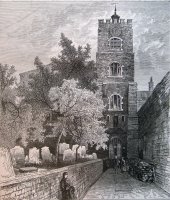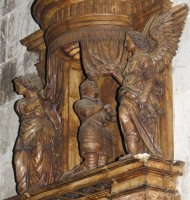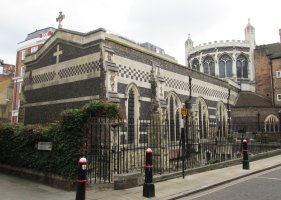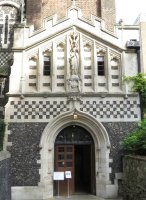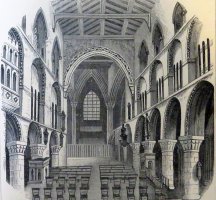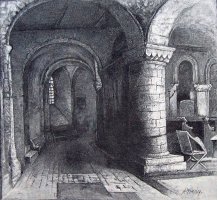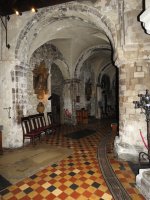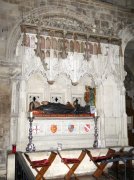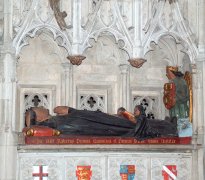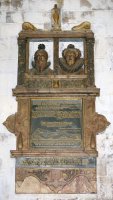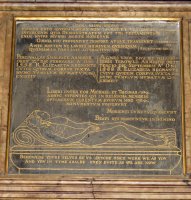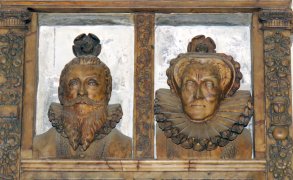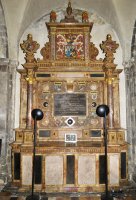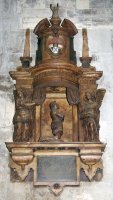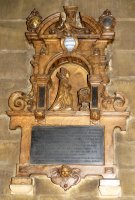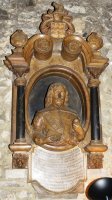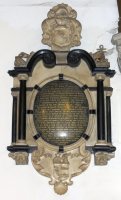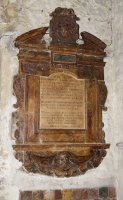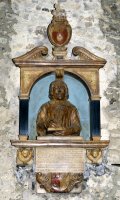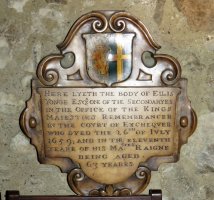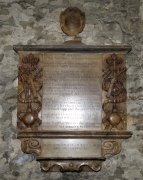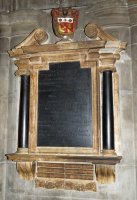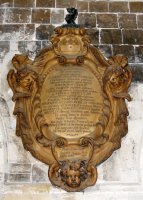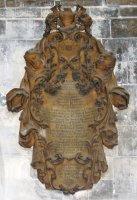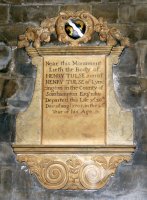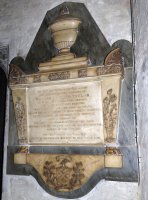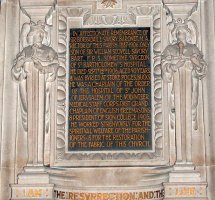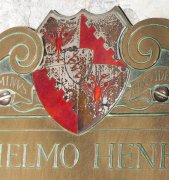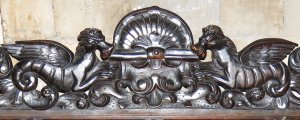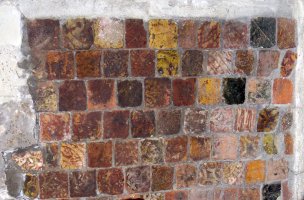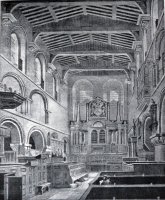St Bartholomew the Great Monuments
St Bartholomew the Great, along with its magnificent monastic architecture, preserves a good collection of wall monuments, around half from the 17th century, along with older and later pieces, and the grand tomb of Rahere.
Rahere founded St Bartholomew the Great as a Priory of Canons of St Augustine in the early 12th Century, in 1102 or 1123, and the hospital nearby, after dreaming that St Bartholomew directed him to do so in payment for his sins as a young man: the oldest parts of the surviving structure are from this date. The nave, now almost entirely obliterated, was completed in the 13th Century, and there was some rebuilding in the time of Roger de Walden, Bishop of London at the start of the 14th Century. In 1539 after the dissolution, the nave was destroyed, and the remaining buildings of the Priory sold off by Henry VIII to Sir Richard Rich in 1544, with the condition that the surviving part be a parish church forever. Various vicissitudes, repairs and restorations followed, with the remaining part of the main building kept, and all the outbuildings lost. George Dance Jr and Thomas Hardwick were engaged in the later 18th Century (Hardwick again in 1815), and there was a major restoration in mid Victorian times started by William Slater and T. Hayter Lewis, and then later, Aston Webb. What is left is mostly the choir of the original church, with just a single bay from the nave - in fact, as Rahere died before the nave was built, what we see today from inside is similar in dimensions, if only some of the fabric, to the Priory as he built it. It remains of considerable size, and a significant remnant of an early great Norman priory.
St Bartholomew the Great: External views.
Outside, we approach through a 13th Century gateway under a Tudor gatehouse - it had been hidden under a later façade until re-exposed after bomb damage - to face the present entrance to the Church, with nice chequerboard flintwork and a little statue of Rahere above. This is all 19th Century, but above that, we see the upper storeys of the brick tower, with the bulk of the church to the left.
The Priory Church has a superb ambience, dark and gloomy and with the Norman pillars giving a sense of crushing mass to the structure above, and wants walking around, following the path of the ambulatory and along the choir, several times, ideally on an autumn or winter day with cold light. This site is about monuments rather than architecture; the Royal Commission on Historic Monuments description of St Bart's is a good place to start if you are after architecture. The monuments we have come to see are dotted throughout the interior.
Views of the ambulatory.
Monuments
The Church contains the grand tomb of Rahere, rebuilt in 1405 or 1406 with an effigy and canopy, and two dozen wall panel monuments, three dating from the late 16th Century, through a good group of 13 from the 17th Century pieces, five in the 18th Century, four 19th Century, and one from 1906, plus a couple of modern brass panels. Among these we have several figure pieces - busts and kneelers and two pairs of angels - several carved cherub heads, and a variety of other carved decoration, and overall this can be counted as a superior crop of panels. We start with the Rahere monument, and then note the rest roughly in date order.
Rahere monument. The founder and first Prior of St Bartholomew, who also founded the hospital of the same name, died in 1144, but the structure and effigy we see is largely not so old as that, dating it is thought from 1405/06. He lies recumbent, his tonsured, beardless head on a tasselled cushion, hands raised in prayer, his robes (the Augustinian habit) falling down his body rather than showing any effect of gravity; the style is usual for that period. There are two small monks with books praying, to left and right of the figure at about knee height; perhaps moved from beside the feet at some stage or head. A winged male angel now stands at the foot, really a three-quarter figure as he emerges from what seems to be a cloud, holding his shield of arms. The whole lies on a great tomb, with four quatrefoil panels on each side, each with painted shield of arms, and around and above, a magnificent canopy, with cinquefoil arches, deeply hanging pendants, clustered pillars supporting and crocketed spires above with blind windows between. All dating from 1405, according to information in the Church, while the Royal Commission on Historic Monuments puts it somewhat later, in the late 15th or early 16th Century. Regardless, Rahere certainly seems to be buried under the monument: one of the 19th Century restorations led to his coffin being opened, to reveal a sandalled skeleton - Augustinian priors were buried thus - and a bit of sandal etc was removed and kept as a relic. The grand surround is very similar indeed to the Bernard Brocas tomb in Westminster Abbey; he died in 1395.
Percival and Agnes Smallpace.
Percival Smallpace, d.1558, and his wife Agnes [Tebowld] Smallpace, d.1588. A most interesting piece, combining a finely carved alabaster wall monument with early portrait busts, and a brass. The busts are very good of their type: Percival Smallpace has a splendid forked beard, moustache, and hair tight to his skull, and an ascetic face; he has a broad covering his neck, and we see a bit of his tunic or cloak, with central buttons and a decorated collar. His wife Agnes died 30 years later, and is depicted with skull-like visage, grim around the mouth, hair under a complex hood, a grander ruff than her husband, and a similar decorated collar.
The busts are within rectangular niches, with pilasters to the sides carved with fruit, flowers, ribbons, an hourglass for time passing and grave=digger's tools on her side, also a skull and bound book on his side; the central pillar is floral, as are the panels underneath. On top, two curly sidepieces, and a central pot on a plinth: this whole part of the monument looks rather reconstituted, and I would think there was once a pediment, and the curly bits on top likely on the outer sides of the pilasters, and of course a backing to the busts, which may have been cut down somewhat from their original width - really quite unusual to find busts of that date in this form. Below all this is a dividing shelf, then the central part of the monument consisting of the framed brass, which gives the Latin inscription, and that it was their offspring Michael and Thomas who erected the piece, and with a depiction of the couple lying nude on a bier, with the cheerful English inscription 'Behowlde youre selves by us such once were we as you // And you in tyme shalbe even duste as we are now'. Then another shelf, another Latin panel, and the curvy apron, unusually carved on three backing panels, with a lost shield of arms and low relief floral carving.
Sir Walter Mildmay, d.1589, and his wife Maria Mildmay, d.1576. A grand and splendid piece, filling one bay of the wall, as befits the founder Emmanuel College in Cambridge. It is in three parts: a sideboard-like altar tomb as the base, the coffins within, on which sits the main panel, reaching well above head height, with pillars to the sides and a rich design of coats of arms (some apparently with errors) and cabochons, and above, more heraldic decoration on a grander scale. All in a rich, reddish alabaster or marble, with much gilt and paint, doubtless renewed may times but likely faithful to the original, and the cabochons (round, domed inclusions) being of pinky and black marble, or painted to resemble such, and surrounded with gilt and minor strapwork, and many low relief carved ribbons. More three-dimensional carving at the top, with much mantling to the central arms, lions and a pot above, and strapwork to the sides and around the two subsidiary coats of arms. All very grand, though for my part I would have wished figure carving too. An inscription records that the monument was restored in 1870 by Henry Bingham Mildmay. The piece has been suggested as being by the sculptor Maximilian Colt, as, with more convincing evidence, has a monument to another member of the family in Northamptonshire.
Elizabeth Scuddamore, d.1593. Typical panel, with inscription on a black backing, brownish marble or alabaster frame, with upper shelf and arms within strapwork, and a small basal inclusion. It appears to have lost some sidepieces or perhaps thin pillars.
Chamberlane monument, 1615.
Sir Robert Chamberlane, d.1615. A kneeler monument, with Sir Robert shown kneeling in the centre, arms raised - the hands are gone, but would have been praying. He wears plate armour above pantaloons, and rests on a small tasselled cushion, which is conventional (for lots more on kneeler monuments, see this page). He is within and under a semicircular canopy, projecting forward with hanging drapes to the sides, pulled aside by a pair of angels as large as the figure of Sir Robert himself and a little dominant. They are well composed, solid figures with good drapery over muscular bodies; both with sleeves rolled up, and one showing a brawny leg. Above, an entablature, and then a structure bearing the painted arms within a cartouche, under a broken, curved pediment with what appears to be a baboon on top, arms raised, hands lost like its master. At the base, heavy supports to the main shelf, and a central Latin inscription, which notes Chamberlane's descent from the Norman earls of Tankerville. A work overall of considerable sculptural merit and good composition. Attributed to Maximilian Colt again, or at least in his style, in Pevsner - rather tentatively I would say.
Elizabeth Freshwater, d.1617.
Elizabeth [Orme] Freshwater, d.1617, and her parents John Orme, d.1616, and Mary Orme, d.1618. Another kneeler monument; as with the Chamberlane panel we have a single central figure with lost hands, kneeling on a tasselled cushion. She has an extravagant ruff, and a beehive hairstyle, giving a certain grandeur. In front of her is a faldstool, or prayer stand, with book and draped side, very typical. Above her is a Romanesque arch with carved panels, springing form low pillars with winged cherub heads at the bases, and outer, receding curls and segmented pilasters. Above, central painted arms on a cartouche on the entablature, rising to a helmet within a curved, broken pediment, and the base of some lost ornament above, likely another, larger coat of arms. To the sides, painted arms within cartouches. Below the figure, the lower part of the monument contains the inscription, framed and with a further winged cherub head at the base.
Dr Francis Anthony, d.1623, with an incised wreath borne on three pillars above the inscription to 'that worthy and lerned Francis Anthony Doctor in Physick'. The upper part of the frame is carved as a swan-necked (curly sided) pediment, with central, oversized shield of arms, helm and mantling. The base of the side pieces has nice scrolling to the sides. The inscription writes that 'There needs no verse to Beautify thy praise // Or keepe in memory thy name // Religion virtue and thy skil did raise // A threefold pillar to thy lasting Fame', and also writes that the monument was erected by John Anthony, d.1655.
Sculptor William Wright (attrib) panels.
James Rivers, d.1641. A half-figure statue, much more usual than the tight head and shoulders of the Smallpace busts (see comment above). He is shown in rather flattering stylish mode, with long wavy hair, moustache, and little beard and a smooth, youngish face. He has a wide collar giving him a broad-shouldered frame, a many buttoned jerkin, and across his chest a broad strip with buckle and low relief ornament, all above a twisted drape. His slightly baggy arms have broad cuffs, and in his hands he holds a book, keeping his place with one finger, and some small device which on close examination is his sword-hilt: his arms come forward from the oval frame. To the sides, black-shafted Ionic pillars support a curvy pediment, swan necked as with the Francis Anthony monument, but here more flamboyant in keeping with the bust below. It supports a carved shield of arms, with smaller cartouches of arms to the sides. At the base, the pillars are supported on lion heads, with the inscription in between. Excellent. A very similar panel exists in Norfolk, in Honington, to Thomas Richardson, with the same composition of oval recess, oversized curly pediment, similarly shaped inscribed panel, and those squared-off lion's head brackets supporting the flanking pillars, and another similar composition, without a bust, in Willesden Church to Sir John Franklyn. All are of the 1640s, and are attributed to the sculptor William Wright (d.1654), a significant monumental sculptor with works in Westminster Abbey known for his blissful or wilful dismissal of conventional sense of proportion and mixture of styles.
Anthony Lowe, d.1641, erected by his wife Maria Rowe. Another rich 17th Century panel, with double-width frame, the outer part with carved enrichments: note particularly the small carved flowers rising form the base to the sides. At the top, the carved shield of arms, within a fine cartouche, sits within and above a curved, broken pediment. At the base, a shallow apron, with low relief carving of a skull peeking out from hanging drapes as a memento mori.
Mid-17th Century: Lowe and Cooke monuments.
Edward Cooke, d.1652. Another half figure carving. Similar in hair and beard to James Rivers noted above, but less stylish. He has a narrower collar, and wears robes open at the front to reveal a many buttoned shirt with a tie at the top and little acorn termini. One over-large hands holds a book, with the other resting a pen upon it, for he is described as both a learned philosopher and man of medicine. The bust is within a round-headed arch, bearing a swan-necked pediment on top with no entablature, and enclosing a shield of arms within a cartouche. Beneath, a Latin inscription, and then English prose referring to the monument, which is always nice: 'Unsluce yo'r briny floods, what can yee keepe // Yo'r eyes from teares, & see the marble weepe // Burst out for shame or if yee fine no vent // For teares, yet stay, and see the stones relent'. To the sides of this survive two winged cherub heads, and beneath , a shield of arms with stylised foliage and scrolling around it: the backing of this lower part, and a little ornament is lost. Suggested as being by the successful 17th Century sculptor Thomas Burman (1617/18-1673/74), a somewhat dubious character who got his wife's maid pregnant and foisted the young woman on one of his assistants, John Bushnell.
Ellis Yonge, d.1659. A modest panel, cut somewhere between a cartouche and strapwork, rather effective. With a painted shield of arms and scrolling.
Ellis Yonge and Capt. John Millet.
Captain John Millet, d.1660, 'Marriner'. A different ornamental treatment, with the most ornate carving, or at least that which survives, to left and right of the quite jolly rhyming inscription: pots at the base, ribbons above, central and snaking left and right and tied at the top, and various compasses and measuring devices of a navigator, all carved in high relief. At the base, a bit more carved scrolling, but at the top, all that survives is a small, worn cartouche, now placed centrally on the upper shelf, but perhaps originally one of a pair to the sides with some larger central piece.
Thomas Roycroft, d.1677, erected by his son Samuel Roycroft. Another characteristic 17th Century piece, more architectural than sculptural, with Ionic pillars to the sides, black shafted and tall, a complex upper, and swan-necked pediment with carved and painted shield of arms. The base is interesting: between the curly brackets, the apron has rather nice floral festoons, and above, we see the spines of books as props to the monument, unusual while by no means unprecedented - the reason is that he was 'the King's Printer in Eastern Languages… renowned among foreigners on account of the books published in his most elegant type'.
Later 17th Century: Roycroft and Kellond.
John Whiting, d.1681, and wife Margret Whiting, d.1680; the first of two panels to this family. The inscribed panel has carved foliage and scrolls to left and right, festoons and shield at the base, and larger carved and painted arms at the top. These latter sit within a roundel carved with strapwork in a very characteristic design, but really rather late for this style, which seems to become common in Tudor monuments from around the 1580s and fade away after 1630.
Johannis Kellond [John Kellond], d.1685, with a Latin inscription. A cartouche monument, thus shaped rather like the carapace of a turtle, domed somewhat in the centre, and with complex, carved surround. This one is particularly elegant: we see ever-decreasing curls rising from the base, and outside of these ,hanging, fringed drapes from which peer a pair of cherubs to the upper sides, with carved knots above. The drapes flow then to the upper centre, where is a smaller cartouche bearing the shield of arms with a horse head above; another small, broad cartouche at the base contains Kellond's dates, and beneath this, a third winged cherub head. See picture above right (click to enlarge).
James Master, d.1702, his mother Ann [Oxenden] Master, d.1705, 99 years old, and son Streysham Master, d.1724. Here we have an example of a cooler, less ornamented monochrome panel of a type which became popular from the 1680s. Ther is a simple frame, with outer curls, bearing a plain curved pediment with a cartouche of arms at the top. Beneath the lower shelf is the inscription to the son, Steysham Master, noting that he 'particularly distinguish[ed] himself // in ye Engagement against ye Spaniards // On ye Coast of Sicily: by forcing the Spanish Admiral in Chief to Surrender to him.' With minor carved pendants, and lacking further ornament.
Ino [John] Whiting, d.1704, and his wife Mary Whiting, d.1727. Another fine cartouche monument, and an interesting comparison with that to John Kellond noted above. Again, the broad border, lavishly carved with foliage and drapery, with here more ornate and naturalistic flowers, and hanging tassels. As usual, winged cherub heads to the upper sides, and knotted drapery, but unusual in the positioning of both. The shield of arms has a well carved helm and mantling above, and Mary, his wife gets the small cartouche at the base. A fine overall composition, with consciously complex outline.
Early 18th Century: Whiting and Tulse.
Henry Tulse, d.1705, with the upper painted arms within a cartouche with festoons of flowers to the sides, ambitious in their carving. At the base, an apron with scrolls and foliage carved in relief.
Margaret Fielder, d.1739. The panel has a raised central semicircle, containing nothing, and there is outer scrolling to the sides and a curvy, scrolly base.
Lockyer Davis, d.1791, and his wife Mary Davis, d.1769. Plain panel with upper and lower shelf and supporting brackets.
Revd. Owen Perrott Edwardes, Rector, d.1814. Modest low panel with side pilasters and upper shelf, and small feet.
White on black panel to W. Taylor, d.1829
William Philips Taylor, d.1829, erected by his mother. An example of a more ornate white-on-black panel, with a short obelisk on top with a pot in front carved in low relief. The inscription below is on the side of a casket, with low relief carving on the lip and sides, which bear poppies as a symbol of sleep. It rests on little lion's feet, beneath which is a shelf and apron bearing the carved arms. On a dark backing panel, and signed by the stonemason, W. Mullane of New Road, St Pancras, who has a number of tablets dotted around London and nearby - the one to Frances Belchier, d.1832 in St Martin's Ludgate is similar in composition and its elements to the St Barts tablet (there is a picture on that page). Lots more about white-on-black tablets on this page.
Mary Wheeler, d.1824, and her husband Daniel Wheeler, d.1834, erected by their grand-daughter Charlotte Hart, 1866. A plain white stone tablet. And under it, a brass panel to the said Charlotte Hart, d.1891, 41 years Sextoness of the Church and who left funds towards its restoration, with no ornament but nice Arts and Crafts text.
Sir Borradaile Savory, Baronet, d.1906, Rector of the Parish 1887-1906, erected by parishioners and friends. A curious mix of Arts and Crafts and Classical Baroque design in white stone. The inscribed panel is in 1900s lettering, as are the pair of half-angels acting as caryatids to the sides, with their soft faces, swirly hair, and long swords. The surround, with fireplace-like composition and raised pediment with a painted shield of arms, helm and mantling, shelf and curly brackets below, is Baroque.
We may mention too just a couple of the modern brasses:
William Henry David Boyle, d. 1897, with line border and at the top, a curly pediment with shield of arms in red enamel and lost black or dark paint.
George William Norton Stevens, Thomas Reginald Walker, and Ralph Paynter Williams, d.1899-1902 in the Boer War. A more traditional black lettered panel with a few red principal capitals, with a maze-design border and crosses at the corners.
Coat of arms, William Boyle brass.
Sir John Deane, Priest and Rector of the Priory Church, founder of the Witton Grammar School in, Northwich, 1557, is commemorated by a brass panel in the floor, dated 1893. With a large cross with quatrefoils, set into black stone.
And finally on the monuments, there are several 20th Century panels, simple and plain, including a group oval ones to musicians associated with the Church.
Also in the Church:
A 13th Century stone coffin, resting under one of the windows.
Medieval tiles.
Set in the wall is a group of medieval tiles, red and white and yellow and black, a bit of green, showing parts of geometric patterns.
The octagonal-sided font, stone, 15th Century. Hogarth was baptised in it.
Below the oriel window, also elsewhere, may be seen the bolt and tun [barrel], rebus of Prior William Bolton, thus early 16th Century.
The 18th Century parish chest, rather plain.
The 19th Century reredos, depicting Rahere and other figures, in a bright, illustrative style suggestive of the tracts of Christian Society textbooks of the time, and a little sweet for modern taste, though of high quality as a work of draftsmanship.
Also 19th Century is much of the tiled floor, a pattern of red, yellowish, white and black tiles as per medieval colours, excellently setting off the walls and contributing to the general ambience.
A large panel recording the Priors and subsequent Rectors of St Bartholomew the Great, erected 1904 in memory of Joseph Grimshire, d.1901. With carved Coat of arms with supporting angels above, and Arts and Crafts font.
A large World War 1 memorial to the City of London Yeomanry, with a rather austere pair of angels to the sides of the screen with the names of the fallen, and a smaller St George and the Dragon carved in relief in the tympanum above. Extra side panels record the fallen of WW2.
A 1950 War Memorial panel to the 600 City of London Squadron Royal Auxiliary Air Force. Pale stone with the regimental arms in colour.
A Risen Christ in terra cotta, by the modern, long-lived sculptor Josefina de Vaconcellos (1905-2005), born in Brazil and who lived in the Lake District from the 1930s. Comparable in style to other South American sculptural works in London - see particularly the upper face, and the curious manner of the neck.
There are various modern artworks etc in the Church, and we may note en passant a splendid drawing of the interior of the Church by Christoper Green, a disturbing Damien Hirst sculpture of St Bartholmew holding his own flayed skin, and a crucified Christ (Golgotha) by Richard Harrison, but such things as these are well outside the ambit of this website.
St Bartholomew the Great's website is at https://www.greatstbarts.com/about-st-barts-the-great/.


